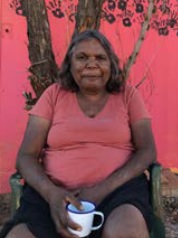“Punmu, I went there when I was a young girl, a teenager with my mother and father before my mother passed. Big mob of people was there. No building, just little cubby houses [bough shelters]. Long time I been there.
These here are the waterholes around Punmu; Rawa spring- Rawa means ‘long time’, Tuu-tuu, Jila-jila, Wirlarra and Yilyara. That is my ngurra (home Country, camp). We grew up in Punmu around all these water holes. I still live here with my grandkids, [we share the] same stories for all these places.”
MARIANNE BURTON
Punmu refers to a region and an Aboriginal community within its vicinity, located 670km NorthEast of
Newman. Created during the return to Country movement of the 1980s, with the recognition of Martu land rights and native title, the community was named after a nearby Jukurrpa (Dreaming) story. As described by Marianne, Punmu is her ngurra; she grew up in this region with her parents.
Punmu community sits on the edge of a large salt lake known as Nyayartakujarra, or Lake Dora. The lake runs south into Karlamilyi River (Rudall River). Surrounding Punmu are numerous fresh water soaks and
the red tali (sandhills) typical of the area. The most frequently visited yinta (permanent springs) around Punmu include Wirlarra, Rawa, Yilyara, Jila-jila and Tuutuu.
The Country around Punmu features in several Jukurrpa stories. Of particular importance is the story of the Jila Kujarra (Two Snakes), one of the key Jukurrpa narratives for the Martu. Though the story belongs
to Warnman people, it is shared across the Western Desert with several other language groups. The narrative centres on the travels of two snakes as they are pursued by the Niminjarra, spiritual ancestors of the Warnman people.
Before transforming themselves into snakes, the Jila Kujarra were young brothers. As snakes, they began travelling home to their mother, but were intercepted by the Niminjarra, who tracked the Jila Kujarra to Paji, east of Nyayartakujarra (Lake Dora). Though the Jila Kujarra eluded their pursuers here by escaping
under the lake at Paji, they were soon after speared and injured by two Pukurti (initiates with bundled hair) at Nyayartakujarra, who returned with the Niminjarra to cook the snakes at the site of Kumpupirntily (Kumpupintily, Lake Disappointment). As the Niminjarra cut down the length of the Jila Kujarra, the snake’s bladders were pierced, causing an explosion of scalding hot urine in which the Niminjarra all
perished and became black rocks at the site. The spirits of the Jila Kujarra returned to their mother at Nyayartakujarra, where the mother and her sons entered the ground below Nyayartakujarra and remain to
this day.
MARIANNE BURTON
Birth Date 1966
Language Manyjilyjarra
Skin Jangala
Birth Place Jigalong
Home Punmu : WA
 Biography
Biography“I was born in Jigalong, long time [ago in] Jigalong. The old people all got picked up and brought into Jigalong. Them old people all wanted to go back to the desert. We moved to Camp 61 [Ngalkuninya] for a little while and then we all moved this way to Punmu. I was young, thirteen or something when I came to
Punmu.
I like to paint around Punmu rockholes, springs. In the morning, sunset colours, that’s what I’m thinking about. In the plane looking down, I want to do a painting what I’m looking at, it looks nice. I want to do more painting like that. I like painting, it makes me feel good.
I’ve been in Jigalong with my father, learning to paint. I was watching him paint. I stayed with them all day, sometimes I help[ed] him and he told stories. Doing the dot paint, that’s when I learn[ed] on a little canvas.”
MARIANNE BURTON
Marianne was born in Jigalong, moving briefly to Camp 61, an outstation on Bilanooka Station as a child, before settling in Punmu Community, where she still resides. Her father was senior Martu artist Pukina
Burton. Marianne and her father used to sit down together, painting while Pukina told stories about his Country. One day Marianne would like to teach her children and grandchildren the same stories. “Me and [my granddaughter] Azaniah like painting together, sometimes she helps me too. Sometimes my grandson Jake too, he did a couple. I like having my family around to paint.”